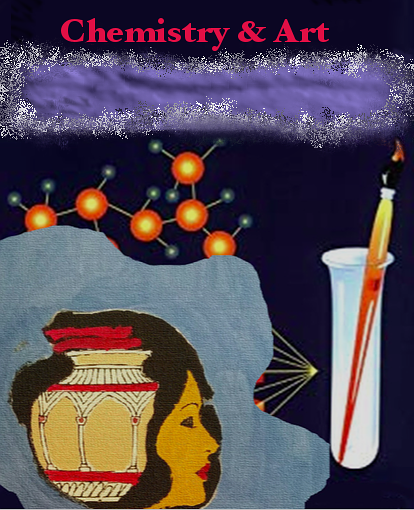Fantasy animal-plant hybrid.
Currently being painted.
Search This Blog
Friday, August 9, 2019
The Waterflow. Graphic Art. David S. Soriano
Currently being painted with gouache/transesterified lanolin emulsified with Span 20 non-ionic detergent. Some 'Gold Bond' skin powder makes a difference in the formulation!
Oil Pastel Experimental Process
I am developing novel oil pastel paint formulations. After blending crayons, jojoba oil, beeswax and oil-based paint, I melt and pour into a four cylinder silicone mold. I insert US quarter and nickel paper rolls in the mold , so it is less messy when working with the cooled paints.
Sections of crayon ( previous post) are cut off and melted with oil-based paint and jojoba oil.
The molten micture is then poured into silicone mold to produce four cylindrical oil pastels.
(I use US quarter or cent paper rolls in the mold . This allows one to keep the hands clean when using the oil pastels.
Experimental Oil Pastel Production
Molten crayons are poured into a 1.0 foot silicone mold. Flashings are broken off. Sections of the crayon cylinder can be sectioned off as needed to blend with oil-based paints to prepare oil pastels. The crayon cylindes Are easily stored this way until needed.
Thursday, August 8, 2019
Trans-Esterified Lanolin- Oil Paint Formulation
Trans-esterification of lanolin with lauryl alcohol and C-18 beta-branched alcohols ( Tin (II) catalyst/ heat. stir 180-210 deg C for 5 hrs) yields a non-'sheep-like odor ' upon cooling to ambient temperature. The creamy product is 'elegant' which means (in cosmetic chemistry) non-greasy.
I found that applied to watercolor paper, it serves as a barrier to oil-based paint leakage which can damage the paper foundation over time.
Mixing the lanolin with an equal mass of a yellow oil-based artist paint, along with 'Gold Bond' powder and some Span-20 (non-ionic surfactant) yields a viscous mass that stirred for 2-3 minutes forms a smooth emulsion.
It applies , with brush, nicely to bristol paper.
The following image shows the paint with various hard/ soft/ oil pastel undercoats:
I will note the drying time (the oil paint has linseed or equivalent resin) which is expected to dry.
I am releasing these findings into the public domain for artists to try out in studies.
i will post my findings as research develops and I will be making a 'You Tube' video in September.
I found that applied to watercolor paper, it serves as a barrier to oil-based paint leakage which can damage the paper foundation over time.
Mixing the lanolin with an equal mass of a yellow oil-based artist paint, along with 'Gold Bond' powder and some Span-20 (non-ionic surfactant) yields a viscous mass that stirred for 2-3 minutes forms a smooth emulsion.
It applies , with brush, nicely to bristol paper.
The following image shows the paint with various hard/ soft/ oil pastel undercoats:
I will note the drying time (the oil paint has linseed or equivalent resin) which is expected to dry.
I am releasing these findings into the public domain for artists to try out in studies.
i will post my findings as research develops and I will be making a 'You Tube' video in September.
Developing Watercolors
The watercolor cakes are allowed to dry, at 20 deg. C, for 2-3 days. The cakes will be emulsified with synthetic petrolatum to , hopefully, form a glaze-like finished appearance.
A Study of Paint Formulations
Watercolor paper ( 9"x12". 140 lb.)
Undercoat: Three (3) developmental oil pastels.
Topcoat: acrylic-synthetic petrolatum emulsion with very inexpensive brown acrylic paint. A small amount of trans-esterified lanolin and 1-2 drops 'Turtle Wax" (liquid car wax) along with a small amount of 'Gold Bond' foot powder which, the latter, makes a difference in brush flow. Amounts of materials and component preparations will be uploaded.
Undercoat: Three (3) developmental oil pastels.
Topcoat: acrylic-synthetic petrolatum emulsion with very inexpensive brown acrylic paint. A small amount of trans-esterified lanolin and 1-2 drops 'Turtle Wax" (liquid car wax) along with a small amount of 'Gold Bond' foot powder which, the latter, makes a difference in brush flow. Amounts of materials and component preparations will be uploaded.
Wednesday, August 7, 2019
Tuesday, August 6, 2019
Developmental Oil Pastel/ Cray-Pas Pastel
Left: Developmental oil pastel using melted crayons, beeswax jojoba oil and commercial oil paint .
A smaller amount of the oil-paint is needed due to the use of the melted crayons that provide pigment.
Right: my favorite commercial oil pastel, Cray-Pas, the oldest commercial product ( 1925 Japan).
The chroma ( hue) is different since the red pigment sources vary!
Both flow on bristol paper nicely.
Monday, August 5, 2019
Sunday, August 4, 2019
Subscribe to:
Posts (Atom)























